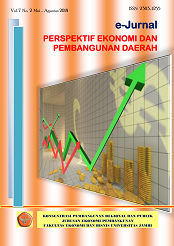Analisis ketimpangan pendapatan pedagang kaki lima di Kota Kuala Tungkal
DOI:
https://doi.org/10.22437/pdpd.v7i2.6890Abstract
This study aims to analyze the socio-economic characteristics and inequality of income of street vendors in Kuala Tungkal City. The data used is sourced from surveys at street vendors. Data were analyzed descriptively and used the gini coefficient and lorentz curve. The results of the study found that street vendors in Kuala Tungkal City were characterized by: 1) Dominated by men with the highest proportion of ages between 26 - 45 years. Merchant education is relatively varied ranging from never going to school to graduating from high school. More than two thirds of them are married with the number of family dependents dominated by 1-4 people. In terms of business location, almost three-quarters of them operate in the market area and only about a quarter of them are trying along the main road. The capital of street vendors in the city of Kuala Tungkal is relatively varied from Rp. 50,000 to over Rp. 1,000,000, with more than half having the same capital or less than Rp. 550,000. Furthermore, in terms of income, most street vendors have an income of Rp. 151,000 - 250,000; 2) Using the method of class three class, the inequality of income of street vendors in the low category with a gini ratio of 0.22772. Furthermore, using the class five class method, the inequality of income of street vendors is also in the low category with a gini ratio of 0.2
Downloads
Downloads
Published
Versions
- 2018-08-22 (1)
- 2018-08-22 (1)





